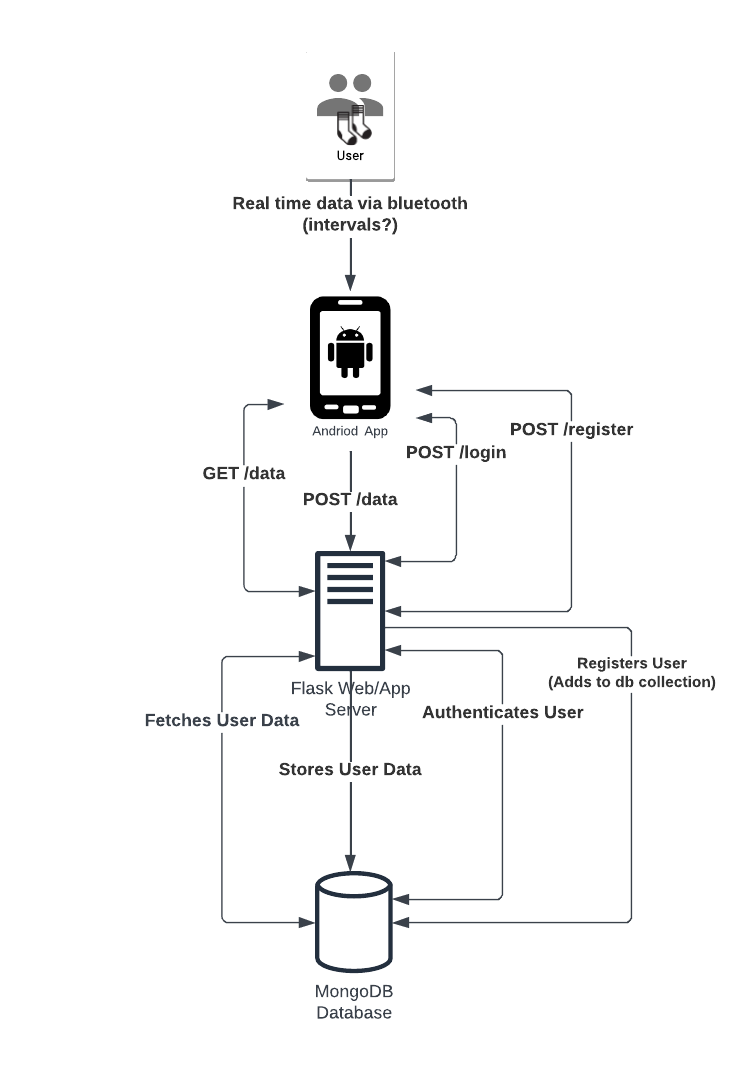Architecture

System Overview
How everything works together:
We do not have all this working functionality.
This is a high-level overview of what we were working towards and how the system would work together.
-
The SmartSocks are the main hardware component.
- It contains sensors that monitor foot temperature and pressure.
- The data collected by the sensors is transmitted to a mobile application via Bluetooth.
- The app analyzes the data and alerts the user if there are any signs of potential foot ulcers or any abnormalities.
-
The mobile app is the main software component.
- It receives and analyzes the data from the smart sock.
- The app is responsible for alerting the user if there are any abnormalities with their readings.
-
The web server backend is built with Flask.
- It is responsible for storing and retrieving data from the MongoDB database.
- The web server backend provides an API for the mobile app to communicate with the database.
-
The MongoDB database stores the data collected by the smart sock.
- The database is used to store historical data and provide insights into the user's foot health over time.
- It is also used to retrieve data for the mobile app to display to the user via graphs, charts, etc.
-
The user interacts with the mobile app to view real-time data on their foot health.
- The app provides alerts and recommendations based on the data collected by the smart sock.
- Notifications are sent to the user if there are any abnormalities detected in the readings.
-
The user can also view historical data and trends in the mobile app.
- This allows the user to track changes in their foot health over time and make informed decisions about their care.
Deep Dive into the components
What we have so far:
Smart Sock (Prototype - Raspberry Pi Pico W):
- We didn't have the time to actually build out the SmartSocks, but we did manage to create a prototype using a Raspberry Pi Pico W.
- The prototype contains 8 temperature sensors and 8 pressure sensors (16 sensors total).
- The Pico W sends a BLE advertisement with a GATT service that contains the sensor data in characteristic values.
- Read more about Bluetooth Low Energy (BLE) here.
Mobile App
- The mobile application is built with Android Studios using Java.
- The app is responsible for receiving and analyzing the data from the smart sock (Pico, in this case).
- We were able to get a lot of functionality working, such as:
- Scanning for BLE devices.
- Connecting to the Pico.
- Reading the sensor data from the Pico.
- Displaying the sensor data in intervals.
- Displaying the sensor data in a chart and heatmap.
- Profile page
- Debugging page
- Registering and logging in users
- For more information on the mobile app, check out the Android App section.
Web Server Backend
- The web server backend is built with Flask.
- It is responsible for storing and retrieving data from the MongoDB database.
- The web server backend provides an API for the mobile app to communicate with the database.
- For more information on the web server and the endpoints available, check out the Flask Backend section.
- The web server is also hosted on render and is accessible via the internet.
- Please note that we can using the free tier of render, by default the server will go to sleep after 1 hour of inactivity. This means that the first request after the server has gone to sleep will take a few minutes/seconds to wake up the server.
MongoDB Database
- The MongoDB database stores the data collected by the Pico.
- We have two collections in the database:
users- stores user information such as username, password and created date.data- stores the sensor data collected by the Pico.
- For a deeper dive into the database and the collections, check out the MongoDB section.
User Interface
- The user interacts with the mobile app to view their sensor data.
- We have a bar chart and a heatmap that displays the sensor data upon request (doesn't update in real-time).
- The user also has a Profile page where they can view and edit their information, such as: Name, Email, DOB, Weight, Height, Doctor's Name, and Doctor's Email.
Conclusion
SafeStep is a very comprehensive full-stack project that involves a lot of moving parts.
We made a lot of progress in a short amount of time, especially considering that we were all very new to some the technologies we were using. SafeStep is a great example of how a team can come together and build something amazing in a short amount of time.
We hope that this project will inspire others to take on similar challenges and build something, no matter how big or small.